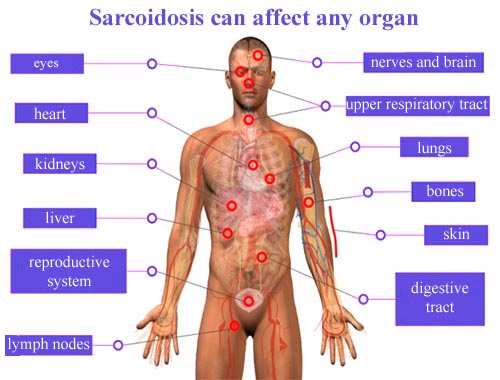Sarcoidosis

Published: 18 Jun 2025
ICD9: 135 ICD10: D86.9 ICD11: 4B20
Sarcoidosis is an inflammatory disease that affects multiple organs in the body, but most commonly the lungs and lymph nodes.
It's characterized by the formation of granulomas, which are clumps of inflammatory cells. These granulomas can interfere with the structure and function of the affected organs.
Here's a breakdown of key aspects of sarcoidosis:
![]() Granulomas: The hallmark of sarcoidosis. These are clusters of immune cells that form when the body attempts to wall off foreign substances or infections. In sarcoidosis, the trigger for granuloma formation is often unknown.
Granulomas: The hallmark of sarcoidosis. These are clusters of immune cells that form when the body attempts to wall off foreign substances or infections. In sarcoidosis, the trigger for granuloma formation is often unknown.
![]() Organs Affected:
Organs Affected:![]()

![]() Lungs: Most frequently affected. Can cause shortness of breath, cough, chest pain, and lung scarring (pulmonary fibrosis).
Lungs: Most frequently affected. Can cause shortness of breath, cough, chest pain, and lung scarring (pulmonary fibrosis).![]()

![]() Lymph Nodes: Enlarged lymph nodes in the chest (mediastinal lymphadenopathy) are common.
Lymph Nodes: Enlarged lymph nodes in the chest (mediastinal lymphadenopathy) are common.![]()

![]() Skin: Can cause various skin lesions, such as nodules, plaques, or rashes.
Skin: Can cause various skin lesions, such as nodules, plaques, or rashes.![]()

![]() Eyes: Can cause inflammation (uveitis), dry eyes, and blurred vision.
Eyes: Can cause inflammation (uveitis), dry eyes, and blurred vision.![]()

![]() Heart: Can lead to heart rhythm problems (arrhythmias), heart failure, and other cardiac issues.
Heart: Can lead to heart rhythm problems (arrhythmias), heart failure, and other cardiac issues.![]()

![]() Nervous System: Can affect the brain, spinal cord, and nerves, leading to neurological symptoms.
Nervous System: Can affect the brain, spinal cord, and nerves, leading to neurological symptoms.![]()

![]() Other organs: Can also affect the liver, kidneys, joints, muscles, and other organs.
Other organs: Can also affect the liver, kidneys, joints, muscles, and other organs.
![]() Symptoms: Sarcoidosis symptoms vary widely depending on which organs are affected and the severity of the inflammation. Some people with sarcoidosis have no symptoms, while others experience a range of problems. Common symptoms include:
Symptoms: Sarcoidosis symptoms vary widely depending on which organs are affected and the severity of the inflammation. Some people with sarcoidosis have no symptoms, while others experience a range of problems. Common symptoms include:![]()

![]() Fatigue
Fatigue![]()

![]() Cough
Cough![]()

![]() Shortness of breath
Shortness of breath![]()

![]() Chest pain
Chest pain![]()

![]() Swollen lymph nodes
Swollen lymph nodes![]()

![]() Skin rashes or lesions
Skin rashes or lesions![]()

![]() Eye problems
Eye problems![]()

![]() Joint pain
Joint pain
![]() Causes: The exact cause of sarcoidosis is unknown. It's believed to be triggered by a combination of genetic predisposition and environmental factors, such as exposure to certain infectious agents or chemicals. Sarcoidosis is not contagious.
Causes: The exact cause of sarcoidosis is unknown. It's believed to be triggered by a combination of genetic predisposition and environmental factors, such as exposure to certain infectious agents or chemicals. Sarcoidosis is not contagious.
![]() Diagnosis: Sarcoidosis can be challenging to diagnose because its symptoms can mimic those of other diseases. Diagnosis typically involves:
Diagnosis: Sarcoidosis can be challenging to diagnose because its symptoms can mimic those of other diseases. Diagnosis typically involves:![]()

![]() Medical history and physical exam
Medical history and physical exam![]()

![]() Imaging tests (chest X-ray, CT scan)
Imaging tests (chest X-ray, CT scan)![]()

![]() Lung function tests
Lung function tests![]()

![]() Biopsy of affected tissue (e.g., lung, lymph node, skin) to confirm the presence of granulomas
Biopsy of affected tissue (e.g., lung, lymph node, skin) to confirm the presence of granulomas![]()

![]() Blood tests to assess organ function and inflammation
Blood tests to assess organ function and inflammation
![]() Treatment: There is no cure for sarcoidosis, but treatment can help manage symptoms and prevent organ damage. Treatment options include:
Treatment: There is no cure for sarcoidosis, but treatment can help manage symptoms and prevent organ damage. Treatment options include:![]()

![]() Corticosteroids: The most common treatment for reducing inflammation.
Corticosteroids: The most common treatment for reducing inflammation.![]()

![]() Immunosuppressants: Medications that suppress the immune system to reduce granuloma formation.
Immunosuppressants: Medications that suppress the immune system to reduce granuloma formation.![]()

![]() Other medications: Depending on the organs affected, other medications may be used to manage specific symptoms.
Other medications: Depending on the organs affected, other medications may be used to manage specific symptoms.![]()

![]() Observation: In some cases, sarcoidosis may resolve on its own without treatment.
Observation: In some cases, sarcoidosis may resolve on its own without treatment.
![]() Prognosis: The prognosis of sarcoidosis varies depending on the severity of the disease and the organs affected. Many people with sarcoidosis experience spontaneous remission or can manage their symptoms with treatment. However, in some cases, sarcoidosis can lead to chronic organ damage and disability.
Prognosis: The prognosis of sarcoidosis varies depending on the severity of the disease and the organs affected. Many people with sarcoidosis experience spontaneous remission or can manage their symptoms with treatment. However, in some cases, sarcoidosis can lead to chronic organ damage and disability.
![]() Epidemiology: Sarcoidosis occurs worldwide, but it is more common in certain populations, such as African Americans and people of Scandinavian descent. It typically affects adults between the ages of 20 and 40.
Epidemiology: Sarcoidosis occurs worldwide, but it is more common in certain populations, such as African Americans and people of Scandinavian descent. It typically affects adults between the ages of 20 and 40.
In summary, sarcoidosis is a complex inflammatory disease characterized by the formation of granulomas in various organs. While the cause is unknown, treatment can help manage symptoms and prevent organ damage. Diagnosis often involves a combination of imaging, lung function tests, and biopsy.
If you suspect you have sarcoidosis, it's essential to see a doctor for diagnosis and treatment.